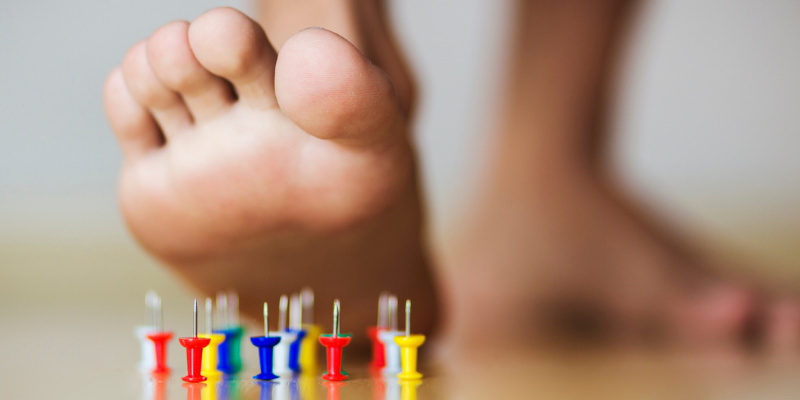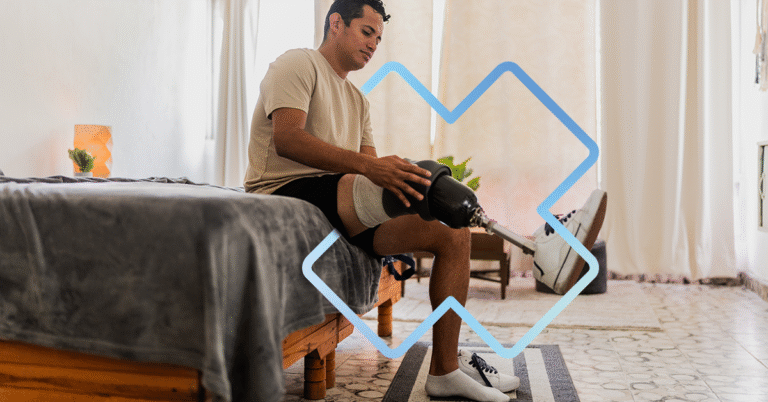What are the common causes?
- Plantar fasciitis is a common condition that causes pain under the foot. The pain is usually located near the heel and may extend toward the front of the foot. It results from irritation or inflammation of a large ligament under the foot called the plantar fascia. This structure helps maintain the shape of the foot and absorbs shock during weight-bearing activities. This injury is mainly caused by overuse or a direct impact. Overuse can occur after a single event (for example, a long walk on uneven terrain) or during a regular activity without sufficient rest (for example, walking barefoot on the beach every day for a week). Generally, the pain is strongest during the first few steps and decreases afterward, only to return when the activity level increases again.
- A stress fracture is always an overuse injury. It sometimes occurs in runners during seasonal changes or when changing shoes, or even after gradually increasing running distance or intensity without enough recovery time. The pain is usually more localized than that of plantar fasciitis and is found under the front of the foot or near the outer edge of the foot. Unlike plantar fasciitis, pain from a stress fracture tends to worsen with walking.
- If the pain is located directly under the heel, it may be due to inflammation of the heel fat pad. This type of pain usually appears after repetitive jumping activities (for example, in gymnasts). The fat pad cushions and protects the heel bone by absorbing impact, but like any tissue, it can become irritated and inflamed if overused.
- Unlike ankle sprains, foot sprains are rare. They typically occur when a heavy object is dropped on the top of the foot, causing overstretching of the ligaments under the foot. The pain is usually well localized at the site of impact, in the middle of the foot.
About heel spurs
Your podiatrist or doctor may have noticed a heel spur on an X-ray. Often, this condition is not painful. A heel spur is a bony formation that develops between the plantar fascia and the heel bone. The body adapts to mechanical stress, and the heel spur is the result of a past inflammation that may no longer be painful. Typically, the pain is located at the fascia’s attachment point rather than at the spur itself. If the bone is painful, your podiatrist can design an orthotic to help reduce pain and inflammation.
I have flat or high arches, is that the cause of my pain?
There is no single answer to this question! Maybe yes, maybe no. You grew up and developed with the foot shape you have. Your body has therefore adapted to the way your foot moves, regardless of its shape. While a flat or high arch can lead to less optimal movement, if your body has adapted to it, the arch shape should not be the first assumption when pain appears. It’s more important to look for what has changed in your daily activities or training routine.
- Have you had an injury on the other leg?
- Have you experienced pain in another joint of the same leg?
- Have you changed anything in your training?
- Have you changed jobs — standing instead of sitting? walking more?
- Do you have new shoes?
These factors are often more closely related to the pain or injury than the foot shape itself.
How to tell if I have flat or high arches?
To determine your foot shape, stand barefoot on a flat surface. Normally, there should be a slight curve along the inside of your foot, without being able to easily slide a finger through it. If that space is reduced, it’s considered a flat foot. If it’s increased, it’s a high arch.
Do I need orthotics or special shoes?
In general, before considering orthotics or specialized shoes, it’s better to review your recent activities and ask yourself the questions listed above. This helps avoid jumping too quickly to the conclusion that orthotics are necessary simply because your arches are high or flat.
Also, before using an orthotic, it’s important to address any biomechanical movement issues that may have contributed to the injury:
- Stiffness in the leg
- Decreased strength in the hips, glutes, thighs, or legs
- Poor movement patterns or posture habits
If orthotics are used too soon, one might miss the full benefits of an exercise-based approach. Orthotics only help while being worn, whereas much of the day is spent without shoes (especially at home). They can also make shoe selection more complicated.
However, some conditions can benefit quickly from added support, such as plantar fasciitis or inflammation of the heel fat pad. Since orthotics can be expensive and often needed only for a short period, it might be worth trying taping to relieve pain. However, taping is temporary, may irritate the skin, and may not provide enough support. In that case, orthotics can be an effective treatment option in collaboration with a podiatrist.
How to relieve pain under the foot?
Here are a few general tips that apply to most types of foot pain:
- Avoid complete immobilization
- Reduce your activity level for a few days : keep moving as long as it’s not painful and avoid activities or walking distances that reproduce the pain.
- Pain often increases after a period of rest or in the morning upon waking. Take time to gently stretch your calf and take small steps after resting to warm up the leg and minimize pain flare-ups.
The physiotherapy approach
The goal of physiotherapy is first to relieve pain, then to identify the cause and provide treatment to recover quickly and prevent recurrence. Physiotherapy combines exercise and manual therapy while guiding you back to your daily and sports activities. Electrotherapy can also be used if needed.
In the case of a stress fracture, your physiotherapist cannot treat the fracture itself but can help adjust your training and manage the resulting stiffness or weakness. It’s common for general stiffness to develop after a fracture. Since the foot is usually rested for a while, this can also lead to a loss of strength and muscle endurance.
If you’re experiencing pain under your foot, don’t hesitate to consult a physiotherapist. They can help you recover and return to your activities safely.





